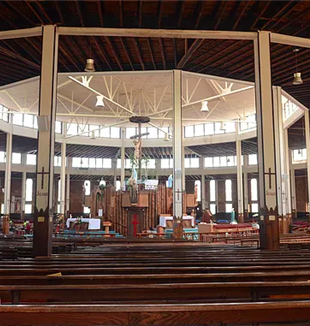
Pilgrims in our own Back Yard
Many Catholics, rocked by years of scandals, seem battle-weary. Rural churches are closing and merging, creating even more layers of uncertainty. Whence comes our help? I wonder...One of the most challenging things for me right now is the difficult state of my parish church. We are in the middle of New York state, far from the many good initiatives I see going on in Washington, D.C., New York City, Philadelphia. Many Catholics, rocked by years of scandals, seem battle-weary. Rural churches are closing and merging, creating even more layers of uncertainty. Whence comes our help? I wonder.
Rita and I were talking about this last fall (Rita, too, originally hails from upstate New York—Rochester). We remembered that it is in the center of New York state that first martyrs’ blood was spilled in this country--certainly, we thought, this must be the seed of God’s merciful for his people! We decided to plan a pilgrimage to the Shrine of Our Lady of Martyrs (also know as the North American Martyrs’ Shrine) in Auriesville, some 35 miles west of Albany. Father Peter Cameron agreed to join us, and the Magnificat Foundation generously offered to underwrite the event.
Unbenkownst to us, at about the same time we were having our conversation, the Society of Jesus was announcing its decision to end its presence at the Shrine. A slow transition of the church and grounds from the Jesuits to the diocese of Albany meant that the buildings were closed to events. For a time, we did not know what was going to happen. But we picked our date, May 14, and then we received the good news that the diocese was hosting an event at the shrine the week before—which would ensure that that the grounds would be open and the facilities ready for people to come.
And so last Saturday we gathered at the shrine in Auriesville, built on the site of the Mohawk village of Ossernenon, where Father Isaac Jogues and René Goupil shed their blood for the faith, and our first native American canonized saint, Kateri Tekakwitha, was born. Pilgrims arrived from all different points in the upstate area. I was so thrilled to see two families from my own parish!
The Coliseum Church, a marvelous structure built to accommodate 10,000 pilgrims, resplendent with statues and relics of the martyrs, was our home for the day. Father Peter spoke of Mary, our Mother of Mercy, her role in shaping our hearts, and his own mother’s beautiful witness. Rita and her nephew Peter told Frank’s story—recalling for us how Christ shone through his sufferings. I shared the richness of the martyrs’ story. Chris and John provided beautiful music through the day, which culminated with Mass for the Vigil of Pentecost.
About thirty children were there, all ages. Rita and I organized games and songs for them, so that their parents could attend the talks. I was able to take a group of children onto the Ravine Trail, my favorite part of the Shrine grounds. Walking there, I feel closest to the Jesuit priests and laymen who came from France to live alongside the natives they were trying to evangelize. They had no churches and could not say Mass. Even when he was weak from torture, lack of food, and exposure, Isaac Jogues made a practice of going into the woods, marking the trees with the name of Jesus and kneeling in prayer. Years later, Kateri, displaced from her tribe because of persecution, went out into the woods to pray as well. She would fashion wooden crosses to focus her prayer, the same crosses we see as her emblem in pictures and statues. In the wilderness, the saints threw themselves open to God’s merciful love. And He did not refuse them!
Following their path, I and my new friend Patty and sixteen children took the Ravine Trail. On the way down, we read the story of the martyrdom of René Goupil and how Isaac Jogues tried to recover his body that had been dragged by the Indians to this wood. Jogues could only find a few bones—and so the ravine itself remains as a wooded cemetery ground, where lie the remains of this humble, simple man, killed because he made the sign of the cross over a native boy. When we reached the clearing at the bottom, we all prayed in front of the oldest shrine statue, a rustic pieta. We offered ourselves to God, throwing open our hearts to His Love! The very fact that we were there, that the pilgrimage had happened at all, was a sign to me—He will not refuse us in our need!